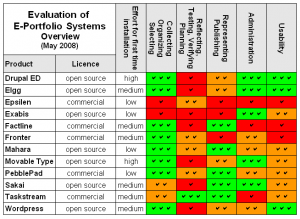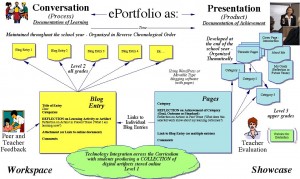What is an e-Portfolio Assessment?
In order to understand an e-portfolio assessment, you should know which categories e-portfolio belongs under in the continuum of the learning assessment. Daniel Hickey will provide a better understanding about portfolio assessment from an instructor’s perspective:
Software products
It’s quite difficult to say which software is an E-Portfolio software. The evaluations of the software products were carried out in the period of April/May 2008 by a panel of 25 E-Portfolio experts, a shortlist of 12 products were created that can be recommended for E-Portfolio implementations in higher education:
What are the purposes in assessing ePortfolios?
“The portfolio assessment allows for the possibility of assessing those complex and difficult‐to‐understand constructs that are often impossible in conventional assessments” (McDonald, 2012).
There are two purposes in assessing the portfolios, one of them is the individual or the student’s evaluation of learning, the other one is used by the institutions to evaluate the program itself. In this page we are going to focus on the student’s perspective.
There is an apparent shift in the educational system from the summative assessment towards the formative process centered assessment; which increases the complexity of the observation of learning (Qvortrup & Keiding, 2015). Among the different forms of evaluation methods, portfolio popped as one of the most effective ways of assessment that left many expectations on this kind of evaluation. However, there are numerous challenges accompanied by the use of portfolio in assessment; the major one is to what extent the portfolio lives up to its expectations (Qvortrup & Keiding, 2015). Since portfolios are described as ‘envelopes of the mind’ (Orland-Barak 2005), and as tools for exploring feelings, values, beliefs and dispositions collected over time (LaBoskey 1993; Smith and Tillema 1998); the challenges come from assessing the mind including feelings and beliefs. In this eportfolio learning commons, we will try to discuss these challenges we face, as instructors, so our assessment would be directed towards enriching the learning process of the student as complementary and scaffolding towards easier learning by motivating reflection on and self-evaluation of the learning processes and achievements. Therefore; we believe that the assessment should be simply focused towards these aspects:
- Degree of transparency (have learned/have not learned) –Reflection and reflexivity- by documentation of learning process and achievements.
- Stimulation of learning
- Autonomy and self-directed
Strategic & Realistic Assessment of Interactive ePortfolios
It is important for the students to continually assess the quality of their ePortfolios by using a rubric. In this rubric assessment tool, students should identify progresses they could make to their work as an ePortfolio and the assessment can enhance deep learning.Click here for more information about rubric assessment.
Useful resources:
- ePortfolio in Education. Practices and reflections
- How to Write a Reflective Statement
- How to structure your eportfolio
- Rubric Evaluation
- Building a College Portfolio: Suggested Activities
- Effective e-Portfolios
Bibliography
Qvortrup, A., & Keiding, T. B. (2015). Portfolio assessment: Production and reduction of complexity. Assessment & Evaluation in Higher Education, 40(3), 407-419
McDonald, B. (2012; 2011). Portfolio assessment: Direct from the classroom. Assessment & Evaluation in Higher Education, 37(3), 335-13.
Activity: In portfolio assessment by the teachers, do you think that having an explicit set of criteria in assessing the portfolio serves the purpose of the reflective learning that the students should practice? Please feel free to comment in this blog:
Want to contribute your thoughts or suggestions about this page?


 Follow
Follow
Activity: In portfolio assessment by the teachers, do you think that having an explicit set of criteria in assessing the portfolio serves the purpose of the reflective learning that the students should practice? Please feel free to comment in this blog: